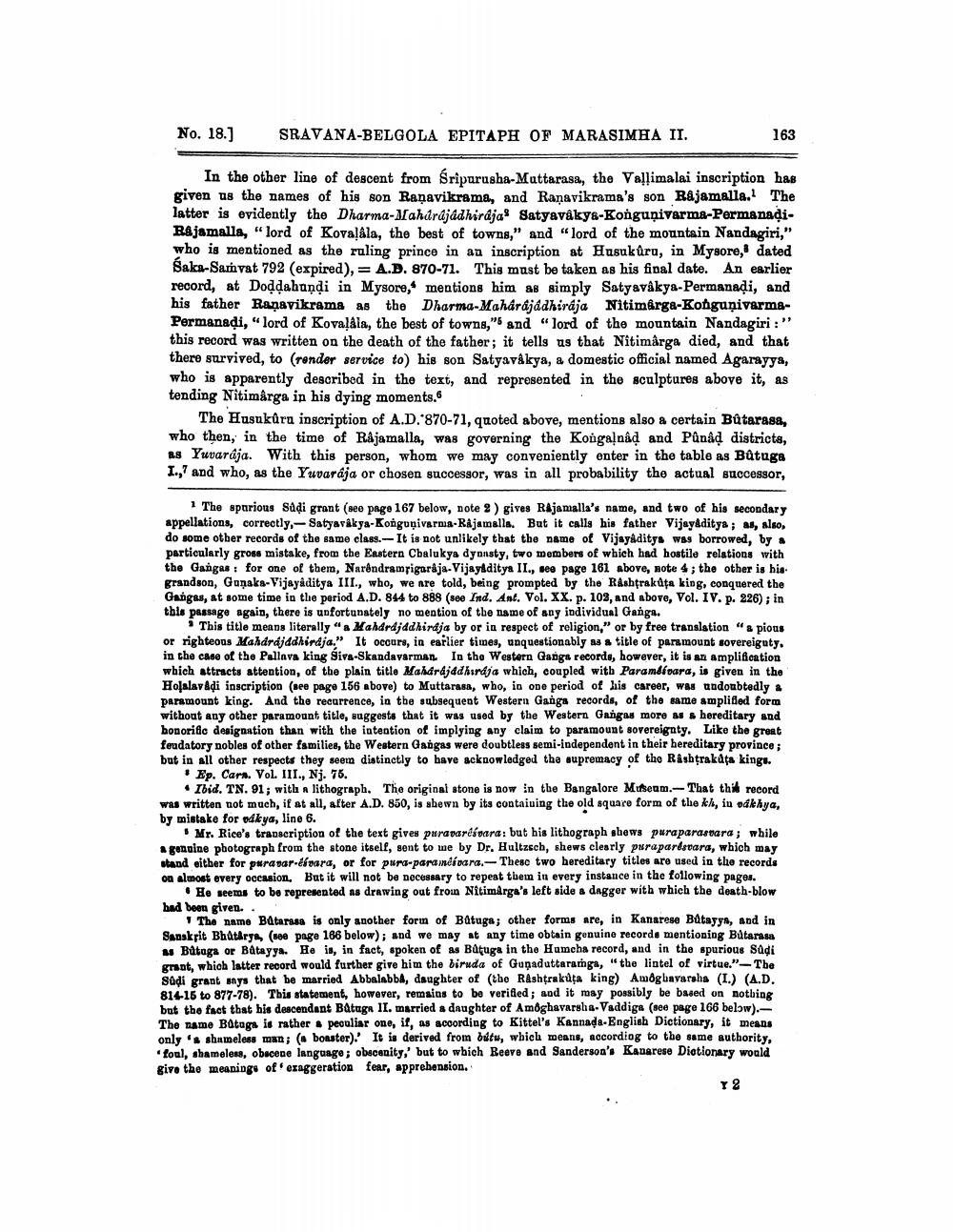________________
No. 18.]
SRAVANA-BELGOLA EPITAPH OF MARASIMHA II.
163
In the other line of descent from Sripurusha-Muttarasa, the Vallimalai inscription has given us the names of his son Raņavikrama, and Raņavikrama's son Rajamalla. The latter is evidently the Dharma-Maharajadhiraja' Satyaváky&-Konguņivarma-Permanadi. Rajamalla, “lord of Kovaļala, the best of towns," and "lord of the mountain Nandagiri," who is mentioned as the ruling prince in an inscription at Husuk uru, in Mysore, dated Saka-Samvat 792 (expired), = A.D. 870-71. This must be taken as his final date. An earlier record, at Doddahandi in Mysore, mentions him as simply Satyavákya-Permanadi, and his father Ranavikrama as the Dharma-Maharajadhiraja Nitimarga-KonguņivarmaPermanadi," lord of Kovaļala, the best of towns," and "Lord of the mountain Nandagiri :" this record was written on the death of the father; it tells us that Nitimârga died, and that there survived, to render service to his son Satyavákya, a domestic official named Agarayya, who is apparently described in the text, and represented in the sculptures above it, as tending Nitimârga in his dying moments.
The Husukūru inscription of A.D.-870-71, quoted above, mentions also a certain Bûtarasa, who then, in the time of Rajamalla, was governing the Kougalnâd and Pûnad districts, as Yuvarája. With this person, whom we may conveniently enter in the table as Bûtuga I., and who, as the Yuvaraja or chosen successor, was in all probability the actual successor,
The spurious Suđi grant (see page 167 below, note 2 ) gives Rajamalla's name, and two of his secondary appellations, correctly,- Satyavákya-Konguņivarna-Rajamalla. But it calls his father Vijayaditya; as, also, do some other records of the same class. It is not unlikely that the name of Vijayaditys was borrowed, by particularly gross mistake, from the Eastern Chalukya dyonsty, two members of which had hostile relations with the Gangas : for one of them, Narendramrigarája-Vijayaditya II., see page 161 above, note 4; the other is bis.
ndson, Gunaka-Vijayaditya III., who, we are told, being prompted by the Rashtrakuța king, conquered the Gaágas, at some time in the period A.D. 844 to 888 (see Ind. Ant. Vol. XX. p. 103, and above, Vol. IV. p. 226); in this passage again, there is unfortunately no mention of the name of any individual Ganga.
. This title means literally "a Kahdrdjddhirdja by or in respect of religion," or by free translation "& pious or righteous Mahdrájddhirdja." It occurs, in earlier times, unquestionably as a title of paramount sovereiguty. in the case of the Pallava king Siva-Skandavarman. In the Western Ganga records, however, it is an amplification which attracts attention, of the plain title Maharajadhiraja which, coupled with Paramdívara, is given in the HolalavAdi inscription (see page 156 above) to Muttarasa, who, in one period of his career, was undoubtedly a paramount king. And the recurrence, in the subsequent Western Ganga records, of the same amplified form without any other paramount title, suggests that it was used by the Western Gangas more as a hereditary and honorific designation than with the intention of implying any claim to paramount sovereignty. Like the great feudatory nobles of other families, the Western Gangas were doubtless semi-independent in their hereditary province; but in all other respects they seem distinctly to have acknowledged the supremacy of the Rashtrakata kinge.
Ep. Carn. VOL. III., Nj. 75.
Ibid. TN. 91; with a lithograph. The original stone is now in the Bangalore Museum.---That this record was written not much, if at all, after A.D. 850, is shewn by its containing the old square form of the kh, in odkhya, by mistake for odkya, line 6.
Mr. Rice's transcription of the text gives puravarésvara: but his lithograph shews puraparasuara; while A genuine photograph from the stone itself, sent to me by Dr. Hultzsch, shews clearly purapardsvara, which may stand either for purasar-dinara, or for pura-parandídara.- These two hereditary titles are used in the records on almost every occasion. But it will not be necessary to repeat them in every instance in the following pages.
. Ho seems to be represented as drawing out from Nitimarga's left side a dagger with which the death-blow had been given. .
The name Batarasa is only another form of Batuga; other forms are, in Kanarese Batayya, and in Sanskrit Bhatarys, (see page 166 below); and we may at any time obtain genuine records mentioning Batarasa as Bataga or Båtayya. He is, in fact, spoken of as Batuga in the Humcha record, and in the spurious Sadi grant, which latter record would further give him the birida of Gunaduttaramga, "the lintel of virtue."--The Südi grant anys that be married Abbalabba, daughter of the Rashtrakůta king) Amôg bavarsha (I.) (A.D. 814-15 to 877-78). This statement, however, remains to be verified; and it may possibly be based on nothing but the fact that his descendant Batuga II. married a daughter of Amghavarsha.Vaddiga (see page 166 below).The name Bataga is rather peouliar one, if, as according to Kittel's Kannada-English Dictionary, it means only shameless man; (borster).' It is derived from outs, which means, accordiog to the same authority,
foul, shameless, obscene language; obscenity,' but to which Reeve and Sanderson's Kanarese Dictionary would give the meaning of exaggeration fear, apprehension.
Y2




